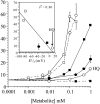The fate of benzene-oxide
- PMID: 20036650
- PMCID: PMC4414400
- DOI: 10.1016/j.cbi.2009.12.025
The fate of benzene-oxide
Abstract
Metabolism is a prerequisite for the development of benzene-mediated myelotoxicity. Benzene is initially metabolized via cytochromes P450 (primarily CYP2E1 in liver) to benzene-oxide, which subsequently gives rise to a number of secondary products. Benzene-oxide equilibrates spontaneously with the corresponding oxepine valence tautomer, which can ring open to yield a reactive alpha,beta-unsaturated aldehyde, trans-trans-muconaldehyde (MCA). Further reduction or oxidation of MCA gives rise to either 6-hydroxy-trans-trans-2,4-hexadienal or 6-hydroxy-trans-trans-2,4-hexadienoic acid. Both MCA and the hexadienal metabolite are myelotoxic in animal models. Alternatively, benzene-oxide can undergo conjugation with glutathione (GSH), resulting in the eventual formation and urinary excretion of S-phenylmercapturic acid. Benzene-oxide is also a substrate for epoxide hydrolase, which catalyzes the formation of benzene dihydrodiol, itself a substrate for dihydrodiol dehydrogenase, producing catechol. Finally, benzene-oxide spontaneously rearranges to phenol, which subsequently undergoes either conjugation (glucuronic acid or sulfate) or oxidation. The latter reaction, catalyzed by cytochromes P450, gives rise to hydroquinone (HQ) and 1,2,4-benzene triol. Co-administration of phenol and HQ reproduces the myelotoxic effects of benzene in animal models. The two diphenolic metabolites of benzene, catechol and HQ undergo further oxidation to the corresponding ortho-(1,2-), or para-(1,4-)benzoquinones (BQ), respectively. Trapping of 1,4-BQ with GSH gives rise to a variety of HQ-GSH conjugates, several of which are hematotoxic when administered to rats. Thus, benzene-oxide gives rise to a cascade of metabolites that exhibit biological reactivity, and that provide a plausible metabolic basis for benzene-mediated myelotoxicity. Benzene-oxide itself is remarkably stable, and certainly capable of translocating from its primary site of formation in the liver to the bone marrow. However, therein lies the challenge, for although there exists a plethora of information on the metabolism of benzene, and the fate of benzene-oxide, there is a paucity of data on the presence, concentration, and persistence of benzene metabolites in bone marrow. The major metabolites in bone marrow of mice exposed to 50 ppm [(3)H]benzene are muconic acid, and glucuronide and/or sulfate conjugates of phenol, HQ, and catechol. Studies with [(14)C/(13)C]benzene revealed the presence in bone marrow of protein adducts of benzene-oxide, 1,4-BQ, and 1,4-BQ, the relative abundance of which was both dose and species dependent. In particular, histones are bone marrow targets of [(14)C]benzene, although the identity of the reactive metabolite(s) giving rise to these adducts remain unknown. Finally, hematotoxic HQ-GSH conjugates are present in the bone marrow of rats receiving the HQ/phenol combination. In summary, although the fate of benzene-oxide is known in remarkable detail, coupling this information to the site, and mechanism of action, remains to be established.
Copyright (c) 2010 Elsevier Ireland Ltd. All rights reserved.
Figures


Similar articles
-
Role of hydroquinone-thiol conjugates in benzene-mediated toxicity.Chem Biol Interact. 2010 Mar 19;184(1-2):212-7. doi: 10.1016/j.cbi.2009.12.016. Epub 2009 Dec 23. Chem Biol Interact. 2010. PMID: 20034486 Free PMC article.
-
Reactive ring-opened aldehyde metabolites in benzene hematotoxicity.Environ Health Perspect. 1996 Dec;104 Suppl 6(Suppl 6):1195-9. doi: 10.1289/ehp.961041195. Environ Health Perspect. 1996. PMID: 9118893 Free PMC article. Review.
-
Benzene metabolism by reconstituted cytochromes P450 2B1 and 2E1 and its modulation by cytochrome b5, microsomal epoxide hydrolase, and glutathione transferases: evidence for an important role of microsomal epoxide hydrolase in the formation of hydroquinone.Toxicol Appl Pharmacol. 1993 Oct;122(2):172-81. doi: 10.1006/taap.1993.1185. Toxicol Appl Pharmacol. 1993. PMID: 8211999
-
Phase II metabolism of benzene.Environ Health Perspect. 1996 Dec;104 Suppl 6(Suppl 6):1183-8. doi: 10.1289/ehp.961041183. Environ Health Perspect. 1996. PMID: 9118891 Free PMC article.
-
Mechanistic considerations in benzene physiological model development.Environ Health Perspect. 1996 Dec;104 Suppl 6(Suppl 6):1399-404. doi: 10.1289/ehp.961041399. Environ Health Perspect. 1996. PMID: 9118926 Free PMC article. Review.
Cited by
-
Degradation of sunscreen agent p-aminobenzoic acid using a combination system of UV irradiation, persulphate and iron(II).Environ Sci Pollut Res Int. 2016 Mar;23(5):4561-8. doi: 10.1007/s11356-015-5631-z. Epub 2015 Oct 31. Environ Sci Pollut Res Int. 2016. PMID: 26517998
-
Cytochrome P450 Can Epoxidize an Oxepin to a Reactive 2,3-Epoxyoxepin Intermediate: Potential Insights into Metabolic Ring-Opening of Benzene.Molecules. 2020 Oct 3;25(19):4542. doi: 10.3390/molecules25194542. Molecules. 2020. PMID: 33023027 Free PMC article.
-
Benzene Uptake and Glutathione S-transferase T1 Status as Determinants of S-Phenylmercapturic Acid in Cigarette Smokers in the Multiethnic Cohort.PLoS One. 2016 Mar 9;11(3):e0150641. doi: 10.1371/journal.pone.0150641. eCollection 2016. PLoS One. 2016. PMID: 26959369 Free PMC article.
-
Strategy for cysteine-targeting covalent inhibitors screening using in-house database based LC-MS/MS and drug repurposing.J Pharm Anal. 2025 Mar;15(3):101045. doi: 10.1016/j.jpha.2024.101045. Epub 2024 Jul 18. J Pharm Anal. 2025. PMID: 40201900 Free PMC article.
-
The Key Role of GSH in Keeping the Redox Balance in Mammalian Cells: Mechanisms and Significance of GSH in Detoxification via Formation of Conjugates.Antioxidants (Basel). 2023 Nov 1;12(11):1953. doi: 10.3390/antiox12111953. Antioxidants (Basel). 2023. PMID: 38001806 Free PMC article. Review.
References
-
- Schultzen O, Naunyn B. The behavior of benzene-derived hydrocarbons in the animal organism. duBois-Reymond's Arch Anat Physiol. 1867;349
-
- Baumann E. Concerning the occurrence of brenzcatechin in the urine. Pflugers Arch Physiol. 1876;12:69.
Publication types
MeSH terms
Substances
Grants and funding
LinkOut - more resources
Full Text Sources

